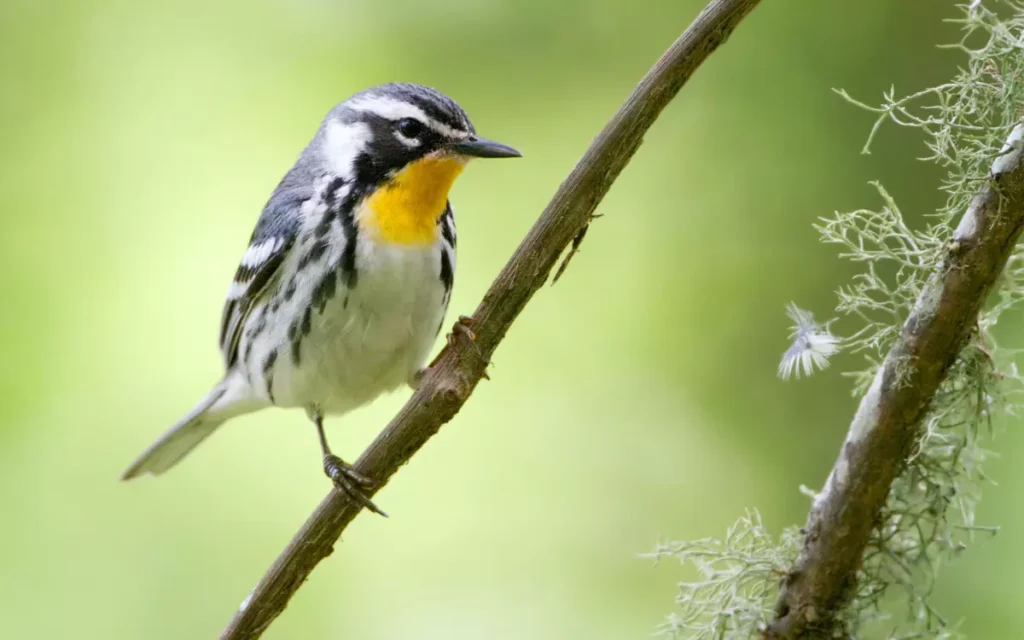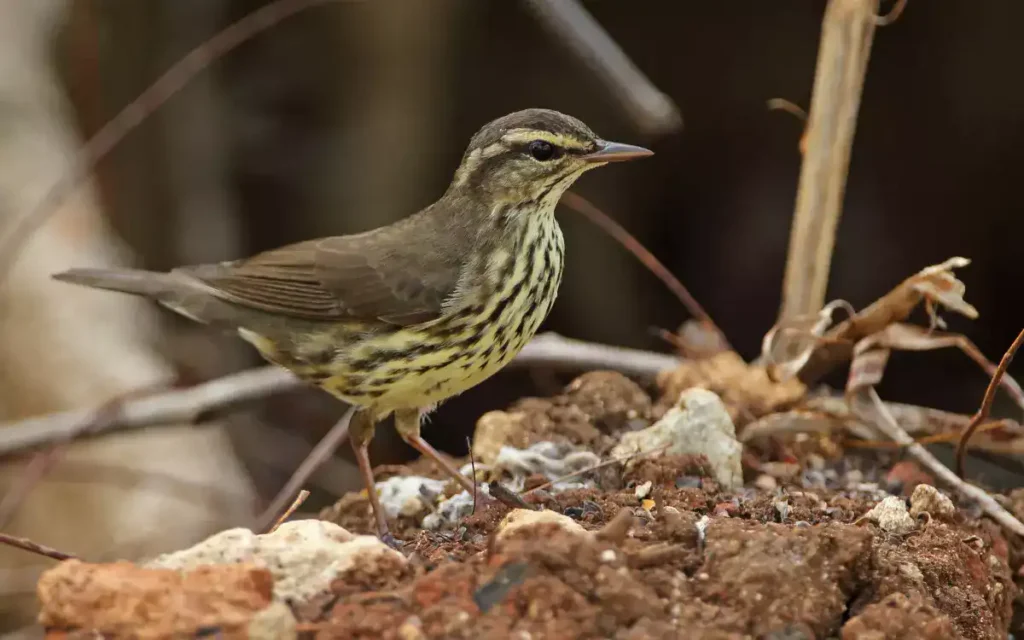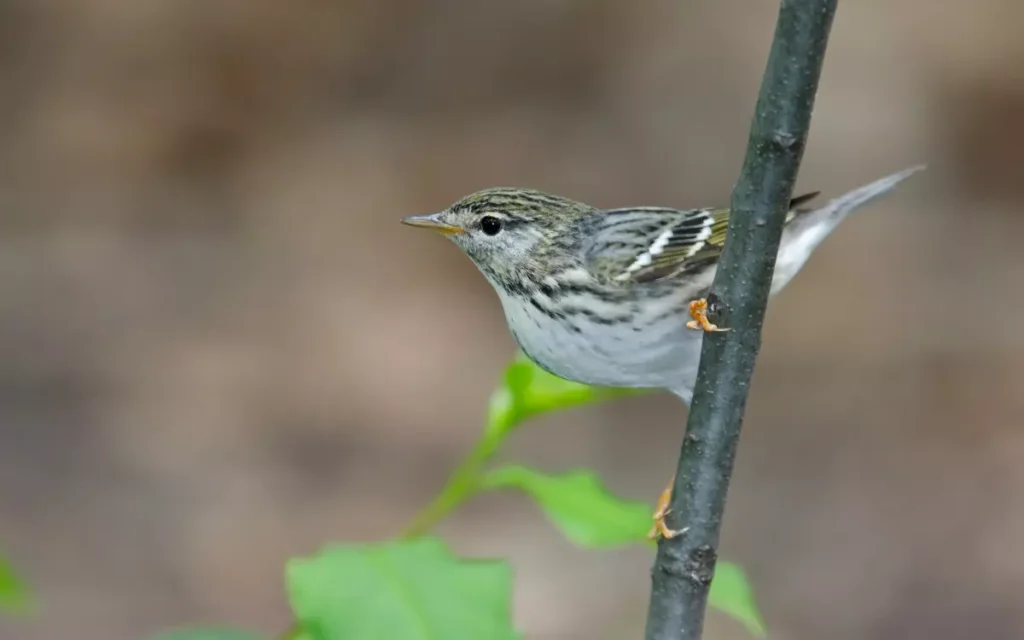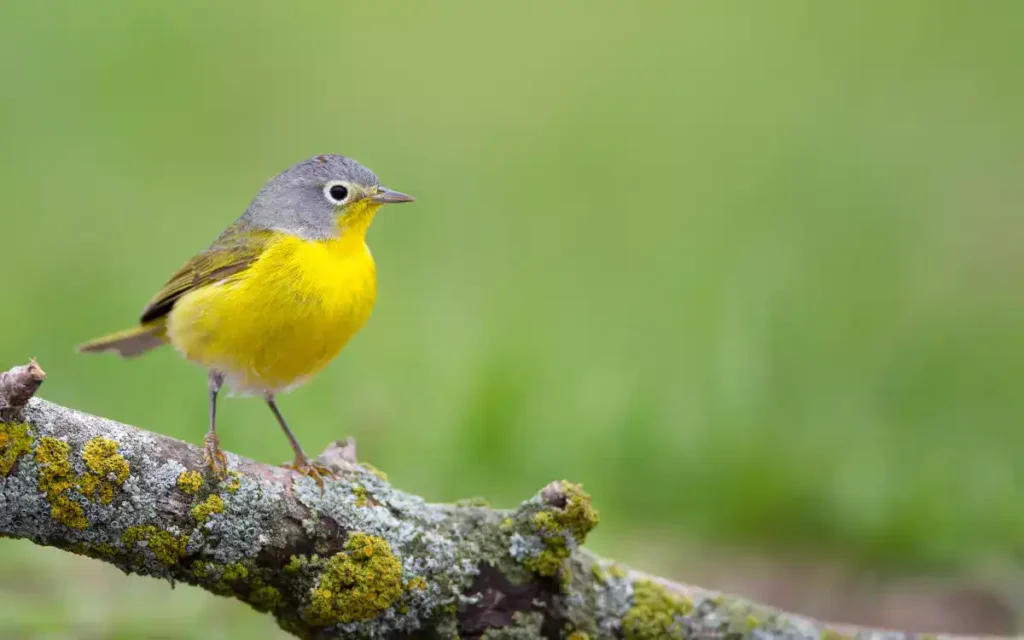36 Species of Warblers In Florida: Length, Weight ,Wingspan

We collected an incredible variety of 36 warblers in Florida. These attractive birds offer a kaleidoscope of colors and songs, making them a must-see for enthusiasts in Florida’s rich ecosystems.
1. Palm Warbler:

The Palm Warbler(Setophaga palmarum) is a small songbird belonging to the warbler family. It has a distinctive appearance with a slightly curved bill, brownish-olive upperparts, and a yellowish underbelly with streaks. During the breeding season, some individuals develop a rusty cap on their heads. They also have a unique tail-wagging behavior.
Palm Warblers are known for their habitat preference, often seen in open woodlands, grassy fields, and areas with scattered shrubs. They are migratory birds, spending their winters in the southeastern United States, the Caribbean, and Central America, and breeding in northern North America. Their song is a simple, high-pitched trill.
Palm Warblers primarily feed on insects and can often be observed hopping on the ground to catch their prey.
- Length: 4.7-5.5 in (12-14 cm)
- Weight: 0.3-0.5 oz (7-13 g)
- Wingspan: 7.9-8.3 in (20-21 cm)
2. Yellow-rumped Warbler:

The Yellow-rumped Warbler (Setophaga coronata) is a medium-sized songbird belonging to the warbler family. It is characterized by its distinctive appearance with a yellow rump, yellow patches on its sides, and a grayish-blue back during the breeding season.
In winter, the plumage changes, and it develops a white throat and yellow spots on its sides. This warbler is commonly found in a variety of habitats, including forests, woodlands, and even urban areas. It has a musical song composed of trills and musical notes.
The Yellow-rumped Warbler primarily feeds on insects, but during winter, it supplements its diet with berries.
- Length: 4.7-5.5 in (12-14 cm)
- Weight: 0.4-0.5 oz (12-13 g)
- Wingspan: 7.5-9.1 in (19-23 cm)
3. Northern Parula:

The Northern Parula (Setophaga americana) is a small New World warbler known for its vibrant colors and distinctive markings. During the breeding season, it displays a bluish-gray upper body, a yellow throat, and a partial or complete white eye ring . Its chest is adorned with a rusty band. This warbler prefers habitats with mature trees and water bodies, such as swamps and wetlands. It has a high-pitched, ascending song that resembles a buzzy trill. The Northern Parula feeds on insects and spiders, often foraging in tree canopies.
- Length: 4.3-4.7 in (11-12 cm)
- Weight: 0.2-0.4 oz (5-11 g)
- Wingspan: 6.3-7.1 in (16-18 cm)
4. Common Yellowthroat:

The Common Yellowthroat (Geothlypis trichas) is a small, energetic warbler known for its distinctive mask-like black markings across its face, which contrasts with its yellow throat and olive upperparts. It exhibits sexual dimorphism, with males having a broader and more defined black mask. This species is often found in marshes, wetlands, and shrubby areas. Its song is a series of rapid, musical notes resembling the phrase “wichity-wichity-wichity.” Common Yellowthroats primarily feed on insects and spiders.
- Length: 4.3-5.1 in (11-13 cm)
- Weight: 0.3-0.3 oz (9-10 g)
- Wingspan: 5.9-7.5 in (15-19 cm)
5. Pine Warbler:

The Pine Warbler (Setophaga pinus) is a small to medium-sized warbler known for its olive-green plumage. During the breeding season, males may exhibit a touch of yellow on their throats and underparts. They are commonly found in pine forests and woodlands, where they forage for insects, particularly in pine trees. Their song is a series of musical trills.
- Length: 5.1-5.5 in (13-14 cm)
- Weight: 0.3-0.5 oz (9-15 g)
- Wingspan: 7.5-9.1 in (19-23 cm)
6. Black-and-white Warbler:

The Black-and-white Warbler (Mniotilta varia) is a distinctive warbler with bold black and white stripes on its plumage, resembling a zebra. It forages by creeping along tree trunks and branches, similar to a nuthatch. It can be found in various wooded habitats and has a high-pitched song with buzzy notes.
- Mniotilta varia
- Length: 4.3-5.1 in (11-13 cm)
- Weight: 0.3-0.5 oz (8-15 g)
- Wingspan: 7.1-8.7 in (18-22 cm)
7.Prairie Warbler:

The Prairie Warbler (Setophaga discolor) is a small, brightly colored warbler with a yellow face, throat, and underparts, and olive upperparts. It prefers shrubby habitats, including old fields and scrubby areas. Males sing a distinctive ascending song with a series of clear notes and trills.
- Setophaga discolor
- Length: 4.3 in (11 cm)
- Weight: 0.2-0.3 oz (6.4-8.8 g)
Read also:-
- 11 Types of Geese Found In Florida
- 14 White Birds in Florida: Exploring Their Length,Weight,Wingspan,Locations
- 9 Blackbirds in Florida: That Attracts You Eyes
- 10 Finches in Florida with Photo
- 9 Most Cutest Tiny Birds In Florida
8. Yellow-throated Warbler:

The Yellow-throated Warbler (Setophaga dominica) is a striking warbler with a yellow throat and underparts, contrasted by gray upperparts. It is often found in mature forests and near water sources. Its song is a series of clear whistled notes, and it feeds on insects and spiders.
- Length: 5.1-5.5 in (13-14 cm)
- Weight: 0.3-0.4 oz (9-11 g)
- Wingspan: 8.3 in (21 cm)
9. American Redstart:

The American Redstart (Setophaga ruticilla) is a lively warbler with black and orange plumage. Males have striking orange patches on their wings and tail, while females are more subdued with yellow patches. They are known for their active foraging behavior, flashing their wings and tails to flush insects. Their song is a mixture of high-pitched notes.
- Length: 4.3-5.1 in (11-13 cm)
- Weight: 0.2-0.3 oz (6-9 g)
- Wingspan: 6.3-7.5 in (16-19 cm)
10. Ovenbird:

The Ovenbird (Seiurus aurocapilla) is a warbler known for its distinctive appearance and unique song. It has an olive-brown upper body with streaks and a bright orange crown bordered by dark stripes. Its song is a loud, ringing “teacher-teacher-teacher” that echoes through the woods. The Ovenbird prefers dense undergrowth in deciduous forests and forages on the forest floor for insects and spiders.
- Length: 4.3-5.5 in (11-14 cm)
- Weight: 0.6-1.0 oz (16-28 g)
- Wingspan: 7.5-10.2 in (19-26 cm)
11. Black-throated Blue Warbler:

The Black-throated Blue Warbler (Setophaga caerulescens) is a small warbler with striking gender dimorphism. Males have deep blue upperparts and a black throat and face, while females display more subdued olive-brown plumage. They prefer deciduous and mixed forests and sing a buzzy song with clear notes.
- Length: 4.3-5.1 in (11-13 cm)
- Weight: 0.3-0.4 oz (8-12 g)
- Wingspan: 7.5-7.9 in (19-20 cm)
12. Orange-crowned Warbler:

The Orange-crowned Warbler (Leiothlypis celata) is a subtle warbler with overall olive-green plumage. Its name comes from the rarely visible orange crown patch that can be seen when the bird is excited or agitated. It has a simple, sweet song and is often found in shrubby habitats.
- Length: 4.3-5.5 in (11-14 cm)
- Weight: 0.3-0.4 oz (7-11 g)
- Wingspan: 7.5 in (19 cm)
13. Northern Waterthrush:

The Northern Waterthrush (Parkesia noveboracensis) is a larger warbler known for its strong preference for wet habitats. It has streaked brown plumage and a bold white eyebrow stripe. Its song is a loud, ringing series of musical notes, and it often bobs its tail while foraging along the edges of streams and wetlands.
- Length: 5.75 inches (15 cm)
- Weight: 0.8 oz (23 g)
- Wingspan: 8.75 inches (22 cm)
14. Cape May Warbler:

The Cape May Warbler (Setophaga tigrina) is a striking warbler with a mix of green, yellow, and rusty plumage. It has a distinctive chestnut cheek patch and a yellow rump. It forages for insects high in trees, often hanging upside down. Its song is a soft, buzzy warble.
- Length: 4.7-5.1 in (12-13 cm)
- Weight: 0.4-0.5 oz (10.2-15.2 g)
- Wingspan: 7.9-8.7 in (20-22 cm)
15. Blackpoll Warbler:

The Blackpoll Warbler (Setophaga striata) is a small migratory warbler known for its remarkable long-distance migrations. During breeding season, males have streaked black and white plumage. They prefer coniferous forests and sing a high-pitched, accelerating song.
- Length: 5.5 in (14 cm)
- Weight: 0.4-0.5 oz (12-13 g)
- Wingspan: 8.3-9.1 in (21-23 cm)
16. Hooded Warbler:

The Hooded Warbler (Setophaga citrina) is a distinctive warbler with a black hood-like mask on males and olive upperparts. Females lack the black hood and have yellowish underparts. They are often found in dense, shrubby habitats near water and sing a clear “witchity-witchity” song.
- Length: 5.1 in (13 cm)
- Weight: 0.3-0.4 oz (9-12 g)
- Wingspan: 6.9 in (17.5 cm)
17. Yellow Warbler:

The Yellow Warbler (Setophaga petechia) is a small, vibrant warbler with bright yellow plumage and reddish streaks on its chest. It is commonly found in a variety of habitats, including wetlands, forests, and gardens. Its song is a series of sweet, rising notes.
- Length: 4.7-5.1 in (12-13 cm)
- Weight: 0.3-0.4 oz (9-11 g)
- Wingspan: 6.3-7.9 in (16-20 cm)
18. Worm-eating Warbler:

The Worm-eating Warbler (Helmitheros vermivorum) is a skulking warbler with streaked brown plumage and a distinct eye stripe. It is often found in deciduous forests, where it feeds on insects and spiders. Its song is a series of high-pitched trills.
- Length: 4.4-5.2 in (11.2-13.1 cm)
- Weight: 0.4-0.5 oz (12-14 g)
- Wingspan: 7.9-8.7 in (20-22 cm)
19. Prothonotary Warbler:

The Prothonotary Warbler (Protonotaria citrea) is a striking warbler with bright yellow plumage and a blue-gray back. It is often found near water sources, such as swamps and marshes. Its song is a rolling, ringing series of notes.
- Length: 5.1 in (13 cm)
- Weight: 0.44 oz (12.5 g)
- Wingspan: 8.75 in (22 cm)
20.Magnolia Warbler:

The Magnolia Warbler (Setophaga magnolia) is a colorful warbler with black streaks on a bright yellow underbody and white undertail coverts. It is often found in trees and shrubs, where it forages for insects. Its song is a musical warble.
- Length: 4.3-5.1 in (11-13 cm)
- Weight: 0.2-0.5 oz (6-15 g)
- Wingspan: 6.3-7.9 in (16-20 cm)
21. Black-throated Green Warbler:

The Black-throated Green Warbler (Setophaga virens) is a vibrant warbler with yellow underparts and a distinctive black throat and face. It has olive upperparts and is often found in coniferous and mixed forests. Its song is a series of high, musical notes.
- Length: 4.3-4.7 in (11-12 cm)
- Weight: 0.3-0.4 oz (7-11 g)
- Wingspan: 6.7-7.9 in (17-20 cm)
22. Tennessee Warbler:

The Tennessee Warbler (Leiothlypis peregrina) is a small, plain warbler with grayish-green upperparts and white underparts. It has a pale eye ring and is often found in dense shrubs and forests. Its song is a simple, repetitive warble.
- Length: 3.9-5.1 in (10-13 cm)
- Weight: 0.3-0.3 oz (8-10 g)
- Wingspan: 7.5-7.9 in (19-20 cm)
23. Chestnut-sided Warbler:

The Chestnut-sided Warbler (Setophaga pensylvanica) is a striking warbler with a yellow crown, white underparts, and chestnut streaks on its sides. It is often found in shrubby areas and young forests. Its song is a mix of buzzy and clear notes.
- Length: 4.7-5.5 in (12-14 cm)
- Weight: 0.4-0.5 oz (10.7-14.3 g)
- Wingspan: 7.5-8.3 in (19-21 cm)
24. Louisiana Waterthrush:

The Louisiana Waterthrush (Parkesia motacilla) is a large warbler with streaked brown plumage and a distinctive white eyebrow stripe. It prefers fast-moving streams and rivers and is known for its habit of walking along streambeds while foraging for insects.
- Length: 5.9-6.1 in (15-15.5 cm)
- Weight: 0.6-0.8 oz (18.2-22.9 g)
- Wingspan: 9.4-10.6 in (24-27 cm)
25. Blackburnian Warbler:

The Blackburnian Warbler (Setophaga fusca) is a stunning warbler with bright orange throat and upper chest, contrasted by black and white plumage. It is often found in coniferous and mixed forests and has a high-pitched song.
- Length: 4.3-4.7 in (11-12 cm)
- Weight: 0.3-0.4 oz (8.9-12.6 g)
- Wingspan: 7.9-9.1 in (20-23 cm)
26. Bay-breasted Warbler:

The Bay-breasted Warbler (Setophaga castanea) is a striking warbler with chestnut-colored streaks on its sides and a pinkish wash on its underparts. It prefers coniferous forests and has a buzzy song with clear notes.
- Length: 5.5 in (14 cm)
- Weight: 0.3-0.6 oz (10-17 g)
- Wingspan: 7.9-8.7 in (20-22 cm)
27. Blue-winged Warbler:

The Blue-winged Warbler (Vermivora cyanoptera) is a small warbler with bright yellow underparts and blue-gray wings. It is often found in shrubby habitats and fields. Its song is a buzzy “bee-buzz” followed by a rising note.
- Length: 4.75 inches (12 cm)
- Weight: 0.3 oz (9 g)
- Wingspan: 6.75 – 7.5 inches (17 – 19 cm)
28. Kentucky Warbler:

The Kentucky Warbler (Geothlypis formosa) is a striking warbler with bright yellow underparts, a black facial mask, and a rich olive-green upper body. It prefers dense undergrowth in woodlands and has a strong, rolling song.
- Length: 5.1 in (13 cm)
- Weight: 0.5-0.5 oz (13-14 g)
- Wingspan: 7.9-8.7 in (20-22 cm)
29. Swainson’s Warbler:

The Swainson’s Warbler (Limnothlypis swainsonii) is a secretive warbler with plain brown plumage and a slightly curved bill. It prefers dense underbrush and is often difficult to spot. Its song is a series of loud, clear notes.
- Length: 5 – 5.5 inches (13 – 14 cm)
- Weight: 0.7 oz (20 g)
- Wingspan: 8.5 inches (22 cm)
30. Yellow-breasted Chat:

The Yellow-breasted Chat (Icteria virens) is a unique warbler with a large, yellow throat and underparts, olive-green upperparts, and a distinctive bill. It often sings from dense thickets and has a varied and melodious song resembling a medley of other bird calls.
- Length: 7.1 in (18 cm)
- Weight: 0.8-1.1 oz (23-31 g)
- Wingspan: 9.8 in (25 cm)
31. Golden-winged Warbler:

The Golden-winged Warbler (Vermivora chrysoptera) is a striking warbler with bright yellow plumage, a black facial mask, and a golden wing patch. It prefers shrubby habitats and sings a buzzy, insect-like song.
- Length: 4.75 – 5 inches (12 – 13 cm)
- Weight: 0.3 oz (9 g)
- Wingspan: 7.75 – 8.25 inches (20 – 21 cm)
32. Nashville Warbler:

The Nashville Warbler (Leiothlypis ruficapilla) is a small warbler with olive-green upperparts and yellow underparts. It has a distinctive white eye ring and a rufous crown patch on males. They are often found in dense shrubs and sing a series of high, musical notes.
- Length: 4.3-5.1 in (11-13 cm)
- Weight: 0.2-0.5 oz (6.7-13.9 g)
- Wingspan: 6.7-7.9 in (17-20 cm)
33. Wilson’s Warbler:

The Wilson’s Warbler (Cardellina pusilla) is a small, bright warbler with yellow underparts and olive upperparts. Males have a black cap, and females have a gray cap. It prefers shrubby habitats and has a high-pitched, rapid song.
- Length: 3.9-4.7 in (10-12 cm)
- Weight: 0.2-0.3 oz (5-10 g)
- Wingspan: 5.5-6.7 in (14-17 cm)
34. Cerulean Warbler:

The Cerulean Warbler (Setophaga cerulea) is a small and striking warbler known for its bright blue upperparts and white underparts. Males have a black streak across their eyes. They prefer mature deciduous forests, especially near water, and sing a high, thin song resembling “zee-zee-zee.”
- Length: 4.5 – 5 inches (11 – 13 cm)
- Weight: 0.3 oz. (9 g)
- Wingspan: 7.5 inches (19 cm)
35. Connecticut Warbler:

Credit: Aaron Maizlish
The Connecticut Warbler (Oporornis agilis) is a shy and elusive warbler with olive-brown upperparts and yellow underparts. It has a gray hood and distinctive white eye-ring. It prefers dense, damp thickets and has a complex song of varied notes.
- Length: 5.5 inches (14 cm)
- Weight: 0.5 oz (14 g)
- Wingspan: 8.75 in (22 cm)
36. Canada Warbler:

The Canada Warbler (Cardellina canadensis) is a small warbler with bluish-gray upperparts, yellow underparts, and a distinctive necklace of black streaks on its yellow chest. It prefers moist forests and sings a series of clear, rising notes.
- Length: 4.7-5.9 in (12-15 cm)
- Weight: 0.3-0.5 oz (9-13 g)
- Wingspan: 6.7-8.7 in (17-22 cm)
FAQS:
What is the most common warbler in Florida?
The Northern Parula is among the most common warblers in Florida. Its vibrant blue-gray plumage and distinctive…
Does Florida have warblers?
Yes, Florida is home to a diverse array of warbler species. The state’s varied ecosystems provide…
What does the Florida warbler look like?
The Florida warbler, often referred to as the “Sunny Yellow Warbler,” is a small bird with bright yellow plumage…
Conclusions:
Warblers in Florida are interesting birds, perfect for any birdwatcher to observe. Their bright colors and sweet songs make them stand out in Florida’s natural settings, creating memorable experiences for anyone who sees them.






